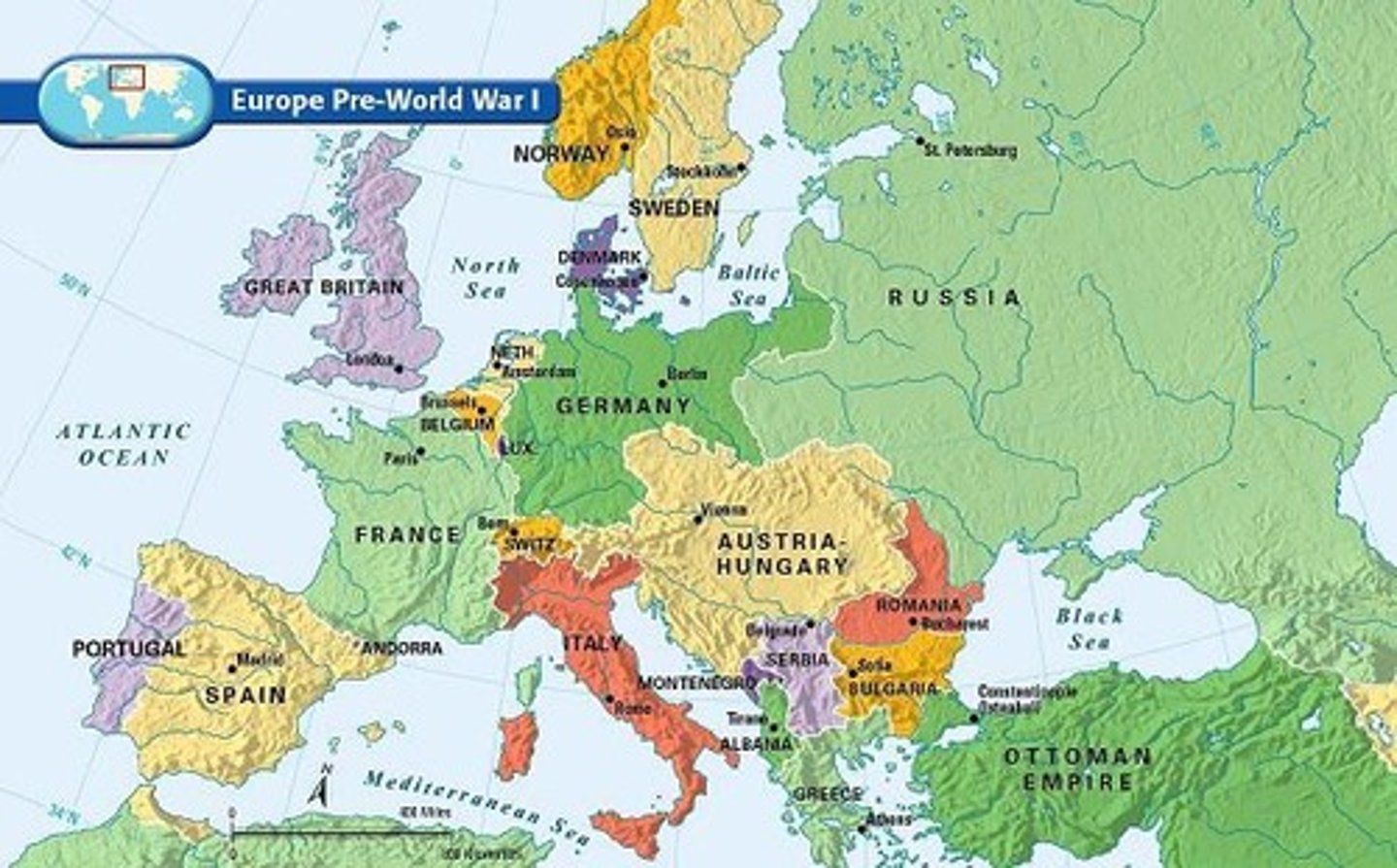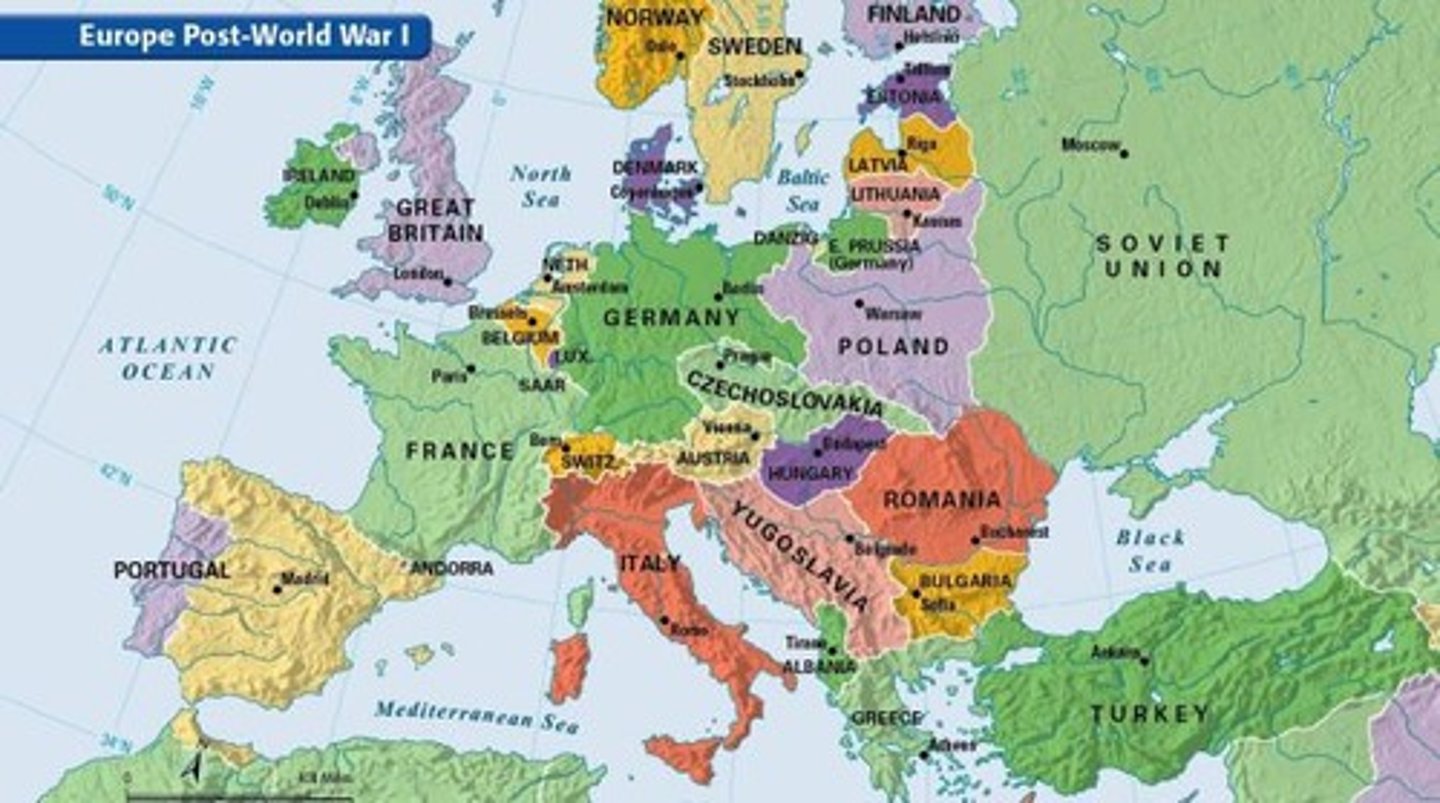US History: WWI Key Concepts and Causes Review
1/30
There's no tags or description
Looks like no tags are added yet.
Name | Mastery | Learn | Test | Matching | Spaced |
|---|
No study sessions yet.
31 Terms
Militarism
This was the development of armed forces, and their use in diplomacy. During World War 1 the cost of building, defending empires led to more military spending.

Alliances
During the war there were many alliances. One alliance was called the Triple Entente, and this was made up for France, Britain, and Russia. While Germany, Austria Hungary, and the Ottoman Empire alliance were called central powers.
Imperialism
When different countries fight for land, this can increase tensions between them and can make them enemies. This can lead to conflicts and even wars.
Nationalism
This is when you love your country a lot, and you brag about it to other countries causing you to compete or become enemies with other countries.
Archduke Franz Ferdinand
The assassination of Archduke Franz Ferdinand by a Serbian nationalist was the breaking point, and the start for World War 1.
Triple Entente
The Triple Entente was an allied group that consisted of France, Britain and Russia.
Central Powers
This was another allied group during World War 1, and this consisted of Germany, Austria-Hungary and the Ottoman Empire.
Woodrow Wilson
He was the president at the time, and before the U.S joined the war he wanted us to stay neutral and to try and not to join the war.
Propaganda
False lies that were told by the government.
Lusitania
This was a British passenger ship that was sunk by a German U-boat in 1915. Over 1,000 people died, including Americans.
Zimmerman telegram
This was a note from Germany to Mexico basically saying that they should create an alliance and attack the U.S.
War Industries Board
Bernard Baruch led the War Industries Board. He helped factories make goods faster using mass production.
Liberty bonds and victory bonds
Liberty bonds were sold during World War I so people could lend money to help pay for the war.
Women in the War Effort
In the war women worked in jobs traditionally held by men. They also gained a lot of support for women's suffrage and the 19th amendment.
Great Migration
Many southern and African Americans migrated to Northern cities due to racial discrimination and job opportunities.
Ways to Avoid War
Diplomatic negotiations, forming alliances for peace, and promoting economic interdependence among nations.
Committee on Public Information
This recruited artists, writers and advertising to encourage Americans to support World War 1, be patriotic, save resources and buy war bonds.
Espionage and Sedition Acts
The Espionage and Sedition Acts punished people who interfered with the war or spoke badly about the government, the war, or the flag. Penalties included fines and up to 20 years in jail.
Schenck v. U.S
This was a Supreme Court case during World War I. It said that people's freedom of speech could be limited if what they say creates a 'clear and present danger' to the country — like encouraging people to ignore the draft.
Selective Service Act
This was an act passed by congress in 1917, creating the draft of men for military service.
Trench Warfare
Trenches are long narrow ditches dug in the ground where soldiers lived and fought during World War 1. These trenches protected soldiers from artillery and guns. Life in the trenches was very hard because it was often wet, muddy, cold and full of rats. The space between enemy trenches, called no-man's land, was very dangerous, and battles often caused stalemates, meaning neither side could move forward easily.
New Technology
Some of the new technology were the tank, airplane, submarine/U-boat, and Zeppelins. The tank was created to plow through the trenches. The airplane was used to drop bombs on other territory, while the zeppelin was used to get intel of where supplies were located. A submarine was an advanced underwater vessel and was an important tool.
Convoys
This was a group of merchant ships sailing together to protect warships.
Why Russia Leaves the War
Russia left the war because they had their own problems and revolution that they had to deal with.
Armistice
A peace agreement that ends fighting in a war. In World War I, it meant the countries agreed to stop fighting on November 11, 1918.

Wilson's 14 Points
This was a list of ideas from President Woodrow Wilson to create peace after World War I. He wanted to prevent future wars, and the 14 Points were meant to help countries solve problems fairly and keep peace.
Treaty of Versailles
The treaty ended World War I, punishing Germany, and tried to set up peace for the future. But the U.S. never ended up signing it because there weren't enough votes in the senate.
Reparations
When Germany surrendered on November 11, 1918 in France. This was an end to the fighting and the beginning of peace talks to try to officially end the war.
League of Nations
This created a place where countries could talk about problems and solve them without fighting. But some Americans, including Senator Henry Cabot Lodge, didn't want the U.S. to join the League of Nations because it might force the country to get involved in other nations' wars.
Big Four
The big four were the main decision leaders at the Paris peace conference and tried to help write the treaty of Versailles, which officially ended the war.
U-boats
This was what the Germans called submarines. The U-boat or submarine was an advanced underwater vessel and was seen as a very important tool during World War 1.